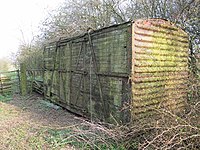
Containerization is a system of intermodal freight transport using intermodal containers. Containerization, also referred as container stuffing or container loading, is the process of unitization of cargoes in exports. Containerization is the predominant form of unitization of export cargoes, as opposed to other systems such as the barge system or palletization. The containers have standardized dimensions. They can be loaded and unloaded, stacked, transported efficiently over long distances, and transferred from one mode of transport to another—container ships, rail transport flatcars, and semi-trailer trucks—without being opened. The handling system is mechanized so that all handling is done with cranes and special forklift trucks. All containers are numbered and tracked using computerized systems.
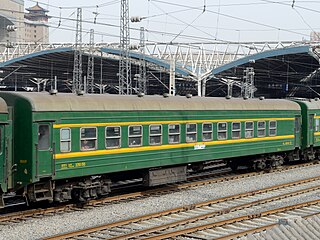
A railroad car, railcar, railway wagon, railway carriage, railway truck, railwagon, railcarriage or railtruck, also called a train car, train wagon, train carriage or train truck, is a vehicle used for the carrying of cargo or passengers on a rail transport network. Such cars, when coupled together and hauled by one or more locomotives, form a train. Alternatively, some passenger cars are self-propelled in which case they may be either single railcars or make up multiple units.

Intermodal freight transport involves the transportation of freight in an intermodal container or vehicle, using multiple modes of transportation, without any handling of the freight itself when changing modes. The method reduces cargo handling, and so improves security, reduces damage and loss, and allows freight to be transported faster. Reduced costs over road trucking is the key benefit for inter-continental use. This may be offset by reduced timings for road transport over shorter distances.
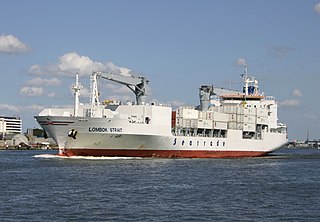
A reefer ship is a refrigerated cargo ship typically used to transport perishable cargo, which require temperature-controlled handling, such as fruits, meat, vegetables, dairy products, and similar items.
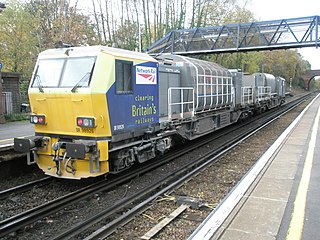
The Multiple-purpose Vehicle or MPV is a purpose-built departmental derivative of a diesel multiple unit. Twenty-five two-car units were ordered by Railtrack to enable it to replace its varied collection of ageing departmental vehicles, many of which were converted from redundant passenger stock.
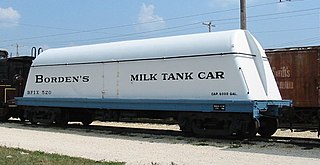
A tank car or tanker is a type of railroad car or rolling stock designed to transport liquid and gaseous commodities.

A flatcar (US) is a piece of rolling stock that consists of an open, flat deck mounted on a pair of trucks (US) or bogies (UK), one at each end containing four or six wheels. Occasionally, flat cars designed to carry extra heavy or extra large loads are mounted on a pair of bogies under each end. The deck of the car can be wood or steel, and the sides of the deck can include pockets for stakes or tie-down points to secure loads. Flatcars designed for carrying machinery have sliding chain assemblies recessed in the deck.

Rail freight transport is the use of railways and trains to transport cargo as opposed to human passengers.
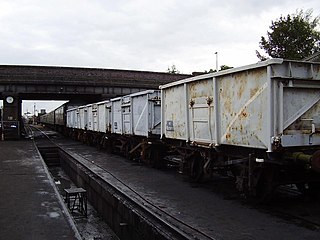
A mineral wagon or coal truck is a small open-topped railway goods wagon used in the United Kingdom and elsewhere to carry coal, ores and other mine products.

A semi-trailer is a trailer without a front axle. The combination of a semi-trailer and a tractor truck is called a semi-trailer truck.

Goods wagons or freight wagons, also known as goods carriages, goods trucks, freight carriages or freight trucks, are unpowered railway vehicles that are used for the transportation of cargo. A variety of wagon types are in use to handle different types of goods, but all goods wagons in a regional network typically have standardized couplers and other fittings, such as hoses for air brakes, allowing different wagon types to be assembled into trains. For tracking and identification purposes, goods wagons are generally assigned a unique identifier, typically a UIC wagon number, or in North America, a company reporting mark plus a company specific serial number.

Flat wagons, as classified by the International Union of Railways (UIC), are railway goods wagons that have a flat, usually full-length, deck and little or no superstructure. By contrast, open wagons have high side and end walls and covered goods wagons have a fixed roof and sides. Flat wagons are often designed for the transportation of goods that are not weather-sensitive. Some flat wagons are able to be covered completely by tarpaulins or hoods and are therefore suitable for the transport of weather-sensitive goods. Unlike a "goods wagon with opening roof", the loading area of a flat is entirely open and accessible once the cover is removed.
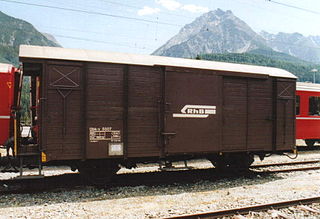
A covered goods wagon or van is a railway goods wagon which is designed for the transportation of moisture-susceptible goods and therefore fully enclosed by sides and a fixed roof. They are often referred to simply as covered wagons, and this is the term used by the International Union of Railways (UIC). Since the introduction of the international classification for goods wagons by the UIC in the 1960s a distinction has been drawn between ordinary and special covered wagons. Other types of wagon, such as refrigerated vans and goods wagons with opening roofs, are closely related to covered wagons from a design point of view. Similar freight cars in North America are called boxcars.

Lowmac is a United Kingdom railway term for a design of low-floored ('well') wagon. A Lowmac's purpose is for carrying vehicles or equipment that would normally be over the recommended height of a normal flatbed wagon, and hence exceed the loading gauge.

The fleet of Great Western Railway wagons was both large and varied as it carried the wide variety of goods traffic on the Great Western Railway (GWR) in the United Kingdom. This was the railway company that operated for the longest period of time in the country and covered a large geographical area that included big cities such as London, industrialised areas including the West Midlands, areas of coal and mineral mining such as South Wales, and Somerset and other important agricultural districts. In 1902 the company owned 59,036 wagons, and by 1926 this had risen to 88,580.
A flatbed trolley a common form of freight transport in distribution environments, for moving bulk loads. Trolleys can aid in reducing effort required to move a load by allowing the user to pull or push instead of lift and carry. A very simple design offers a basic flat platform with four casters and a fixed handle which is used to either push or pull the platform with the load on the platform. Without a flat surface it becomes an open frame trolley and without a handle it is a bogie or dolly.
Between WWI and WWII, the Great Western Railway developed the use of containers that could be packed and locked at a client's premises, taken by lorry to a station, then carried by train and again by lorry to the final destination. Using these containers, they offered a door-to-door removals service, providing a team to pack the furniture, and a discount on fares to the destination. Some containers could carry up to 72 bicycles. Insulated containers, cooled by boxes of ice, were used to transport flower bulbs and other perishable items.
Indian Railways operates India's railway system and comes under the purview of the Ministry of Railways of Government of India. Indian Railways operates more than 4000 cargo and goods trains daily. It hauls variety of cargo to cater to various requirements and have specialized rolling stock corresponding to the cargo hauled. Indian Railways uses a specific wagon numbering system, adopted in 2003.
The Victorian Railways used a variety of flat wagons for the transport of a wide range of loads. Generally speaking, the bogie wagons were custom-built for the job, while the fixed-wheel variants were cut down from former open wagons. Loadings would be placed on the deck and, if necessary, protected with tarps, then secured to the wagons with chains or rope connecting to lashing rings along the side of the wagon frames.
The Condor was an overnight fast freight train service operated by British Railways between London and Glasgow from 1959 until 1965 with all freight carried in containers. The name was derived from 'CONtainers DOoR-to-Door'.



